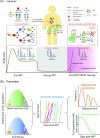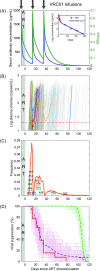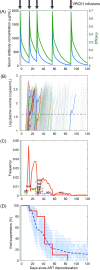Pre-existing resistance in the latent reservoir can compromise VRC01 therapy during chronic HIV-1 infection
- PMID: 33253162
- PMCID: PMC7728175
- DOI: 10.1371/journal.pcbi.1008434
Pre-existing resistance in the latent reservoir can compromise VRC01 therapy during chronic HIV-1 infection
Abstract
Passive immunization with broadly neutralizing antibodies (bNAbs) of HIV-1 appears a promising strategy for eliciting long-term HIV-1 remission. When administered concomitantly with the cessation of antiretroviral therapy (ART) to patients with established viremic control, bNAb therapy is expected to prolong remission. Surprisingly, in clinical trials on chronic HIV-1 patients, the bNAb VRC01 failed to prolong remission substantially. Identifying the cause of this failure is important for improving VRC01-based therapies and unraveling potential vulnerabilities of other bNAbs. In the trials, viremia resurged rapidly in most patients despite suppressive VRC01 concentrations in circulation, suggesting that VRC01 resistance was the likely cause of failure. ART swiftly halts viral replication, precluding the development of resistance during ART. If resistance were to emerge post ART, virological breakthrough would have taken longer than without VRC01 therapy. We hypothesized therefore that VRC01-resistant strains must have been formed before ART initiation, survived ART in latently infected cells, and been activated during VRC01 therapy, causing treatment failure. Current assays preclude testing this hypothesis experimentally. We developed a mathematical model based on the hypothesis and challenged it with available clinical data. The model integrated within-host HIV-1 evolution, stochastic latency reactivation, and viral dynamics with multiple-dose VRC01 pharmacokinetics. The model predicted that single but not higher VRC01-resistant mutants would pre-exist in the latent reservoir. We constructed a virtual patient population that parsimoniously recapitulated inter-patient variations. Model predictions with this population quantitatively captured data of VRC01 failure from clinical trials, presenting strong evidence supporting the hypothesis. We attributed VRC01 failure to single-mutant VRC01-resistant proviruses in the latent reservoir triggering viral recrudescence, particularly when VRC01 was at trough levels. Pre-existing resistant proviruses in the latent reservoir may similarly compromise other bNAbs. Our study provides a framework for designing bNAb-based therapeutic protocols that would avert such failure and maximize HIV-1 remission.
Conflict of interest statement
The authors declare that no competing interests exist.
Figures





Similar articles
-
Use of broadly neutralizing antibodies in pediatric HIV for treatment and remission.Curr Opin HIV AIDS. 2025 May 1;20(3):279-286. doi: 10.1097/COH.0000000000000927. Epub 2025 Mar 3. Curr Opin HIV AIDS. 2025. PMID: 40048578 Review.
-
Effect of HIV Antibody VRC01 on Viral Rebound after Treatment Interruption.N Engl J Med. 2016 Nov 24;375(21):2037-2050. doi: 10.1056/NEJMoa1608243. Epub 2016 Nov 9. N Engl J Med. 2016. PMID: 27959728 Free PMC article. Clinical Trial.
-
Virologic effects of broadly neutralizing antibody VRC01 administration during chronic HIV-1 infection.Sci Transl Med. 2015 Dec 23;7(319):319ra206. doi: 10.1126/scitranslmed.aad5752. Sci Transl Med. 2015. PMID: 26702094 Free PMC article. Clinical Trial.
-
Broadly Neutralizing Antibodies for HIV-1 Prevention.Front Immunol. 2021 Jul 20;12:712122. doi: 10.3389/fimmu.2021.712122. eCollection 2021. Front Immunol. 2021. PMID: 34354713 Free PMC article. Review.
-
Clinical trials of broadly neutralizing monoclonal antibodies in people living with HIV - a review.AIDS Res Ther. 2025 Apr 6;22(1):44. doi: 10.1186/s12981-025-00734-8. AIDS Res Ther. 2025. PMID: 40189566 Free PMC article. Review.
Cited by
-
Modeling resistance to the broadly neutralizing antibody PGT121 in people living with HIV-1.PLoS Comput Biol. 2024 Mar 29;20(3):e1011518. doi: 10.1371/journal.pcbi.1011518. eCollection 2024 Mar. PLoS Comput Biol. 2024. PMID: 38551976 Free PMC article.
-
Trade-off between the antiviral and vaccinal effects of antibody therapy in the humoral response to HIV.J R Soc Interface. 2024 Dec;21(221):20240535. doi: 10.1098/rsif.2024.0535. Epub 2024 Dec 4. J R Soc Interface. 2024. PMID: 39626747
-
Assessing the impact of autologous virus neutralizing antibodies on viral rebound time in postnatally SHIV-infected ART-treated infant rhesus macaques.Epidemics. 2024 Sep;48:100780. doi: 10.1016/j.epidem.2024.100780. Epub 2024 Jun 27. Epidemics. 2024. PMID: 38964130 Free PMC article.
-
SIV proviruses seeded later in infection are harbored in short-lived CD4+ T cells.Cell Rep. 2025 May 27;44(5):115663. doi: 10.1016/j.celrep.2025.115663. Epub 2025 May 5. Cell Rep. 2025. PMID: 40327506 Free PMC article.
-
The risk of drug resistance during long-acting antimicrobial therapy.Proc Biol Sci. 2022 Nov 9;289(1986):20221444. doi: 10.1098/rspb.2022.1444. Epub 2022 Nov 9. Proc Biol Sci. 2022. PMID: 36350211 Free PMC article.
References
Publication types
MeSH terms
Substances
Grants and funding
LinkOut - more resources
Full Text Sources
Medical

